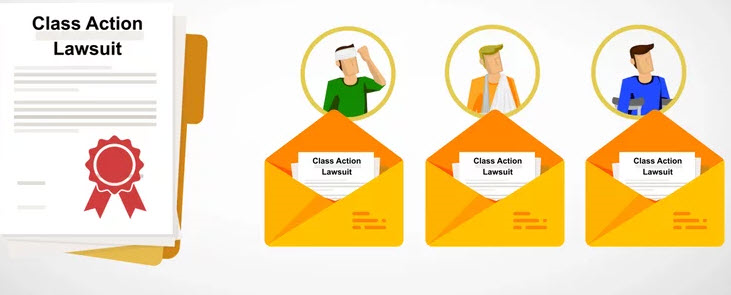Navigating Lawful Seas: Recognizing the Ins and Outs of Class Action Lawsuits
Wiki Article
Comprehending Course Action Legal Action: An Overview for Attorney
Class activity lawsuits have actually come to be an indispensable component of the lawful landscape, enabling the consolidation of multiple claims into a single activity. For legal representatives, recognizing the details of class action litigation is critical in successfully representing their clients. This thorough overview explores the basics of course action suits, from identifying prospective course members to navigating the qualification procedure. In addition, it dives right into essential strategies for taking care of course activity lawsuits and supplies insights right into getting and negotiating approval for negotiations. By diving into the complexities of course activity claims, this guide furnishes attorneys with the expertise and tools required to successfully browse this complex area of law.The Essentials of Class Activity Lawsuits
Class action lawsuits are a legal device employed to consolidate comparable insurance claims from a team of people into a single claim, supplying a economical and effective strategy to seeking justice and resolution. This type of claim enables a representative complainant, acting upon behalf of the whole course, to bring a case versus a defendant who has apparently created harm or broke the legal rights of several people.The basic needs for bringing a course activity lawsuit consist of numerosity, commonality, typicality, and adequacy of depiction. Numerosity refers to the fact that the class must be so large that joinder of all members would certainly be impractical. Commonality implies that there need to prevail inquiries of regulation or reality that are shared by all participants of the course. Typicality calls for that the cases of the depictive complainant are typical of the insurance claims of the entire class. Adequacy of depiction makes certain that the representative plaintiff will adequately represent the interests of the whole course.
Class activity lawsuits can be beneficial for both defendants and plaintiffs. For offenders, it offers the possibility to efficiently settle multiple insurance claims in a solitary suit, staying clear of the requirement to protect against countless individual claims.
Identifying and Assessing Potential Class Members
After developing the basic requirements for a course activity legal action, the following action is to identify and evaluate prospective course participants. This process involves identifying that might be component of the course and evaluating their cases to establish if they fulfill the essential standards.To recognize possible course participants, legal representatives usually perform extensive research and collect pertinent details. This might entail assessing records, performing interviews, and checking out documents to recognize individuals or entities that may have been affected by the supposed misdeed. It is vital to develop a detailed and clear checklist of potential class members to ensure that all affected parties are included in the claim.
As soon as prospective course members have been recognized, the next action is to analyze their cases. This involves examining the qualities of each specific insurance claim to determine if they fulfill the lawful demands for class accreditation. Attorneys must meticulously examine the realities, proof, and legal theories of each possible class participant's case to guarantee that they have a practical instance.
Assessing prospective course members likewise entails identifying whether they fulfill the course meaning and have experienced comparable injury as a result of the accused's activities. This calls for contrasting the realities and situations of each prospective course member's situation to the claims and lawful theories put forth in the lawsuit.
Navigating the Course Qualification Process
To successfully browse the course certification process, attorneys need to vigilantly stick to the procedural requirements set forth by the court. Class accreditation is a vital action in a course activity legal action, as it determines whether a case can continue as a course activity, standing for a team of individuals that have comparable cases versus an offender. The procedure entails pleasing specific criteria, such as numerosity, commonality, typicality, and competence of depiction.First of all, lawyers have to establish numerosity by demonstrating that the course is so huge that specific joinder is not practical. This requires a thorough analysis of the claims and defenses included.
Next, legal representatives need to reveal typicality, which suggests that the representative plaintiff's insurance claims are typical of the cases of the course members. This ensures that the passions of the representative complainant align with the passions of the course. Finally, attorneys need to show adequacy of representation, meaning that the representative complainant and their counsel will relatively and properly represent the rate of interests of the course.
To browse this process efficiently, attorneys have to thoroughly prepare by carrying out extensive research study, collecting proof, and establishing an engaging argument that pleases each of these criteria. They have to also be prepared to reply to any type of objections or challenges increased by the offender. By diligently sticking to the step-by-step demands stated by the court, lawyers can increase their possibilities of getting course certification and progressing the passions of the class members.

Trick Methods for Taking Care Of Class Activity Lawsuits
Upon successfully browsing the class accreditation procedure, attorneys must then implement key methods for successfully taking care of class activity lawsuits. These strategies are essential to ensure that the case proceeds efficiently and efficiently, ultimately taking full advantage of the chances of a favorable result for the course participants.
One key approach is to develop a cohesive and solid lawful group (Class action lawsuit). This entails assembling a team of lawyers with experience in course action lawsuits, along with various other pertinent areas such as the details sector or subject involved in the case. A versatile group can bring various viewpoints and skills to the table, improving the total efficiency of the lawsuits
Another essential approach is to develop a well-balanced and comprehensive litigation plan. This plan should detail the overall goals of the situation, in addition to the details legal concepts and arguments that will be pursued. It should additionally consist of a timeline and budget plan to ensure that the case stays on track and within the allocated resources.
Furthermore, lawyers should actively engage with the course members throughout the litigation process (Class action lawsuit). This consists of giving regular updates on the progression of the case, looking for input and responses from the course members, and addressing any type of concerns or concerns they might have. By cultivating open communication and cooperation, attorneys can develop trust and assistance among the class participants, which can be critical in attaining an effective resolution
Working Out Class Action Lawsuits: Arrangement and Authorization
When it involves settling class activity claims, effective settlement and acquiring approval are vital steps in achieving a resolution. Class activity claims are complicated and involve a a great deal of complainants, making it critical Related Site to get to a settlement that is reasonable and adequate to all parties involved.
As soon as a settlement arrangement is gotten to, it has to be accepted by the court. The court's try these out duty in this procedure is to make certain that the settlement is fair, affordable, and properly shields the passions of the class members. The court will certainly take into consideration aspects such as the nature of the cases, the strength of the evidence, the possible healing for the class members, and any kind of arguments increased by class members.
Obtaining court authorization is crucial as it supplies finality to the settlement and protects the rate of interests of the course participants. It makes sure that the negotiation is binding and enforceable, and course members can get their rightful settlement.
Final Thought

Course activity suits have actually come to be an integral part of the legal landscape, allowing for the loan consolidation of numerous cases right into a solitary activity. Course certification is an essential action in a class action lawsuit, as it establishes whether a case can continue as a class activity, standing for a team of individuals who have comparable cases against an offender. By vigilantly sticking to the procedural demands established forth by the court, attorneys can boost their chances of acquiring course qualification and advancing the interests of the course members.
The court will certainly take into consideration elements such as the nature of the this link claims, the stamina of the evidence, the potential healing for the class participants, and any objections raised by course participants.
By identifying and evaluating prospective course participants, lawyers can figure out the stability of a course action lawsuit.
Report this wiki page